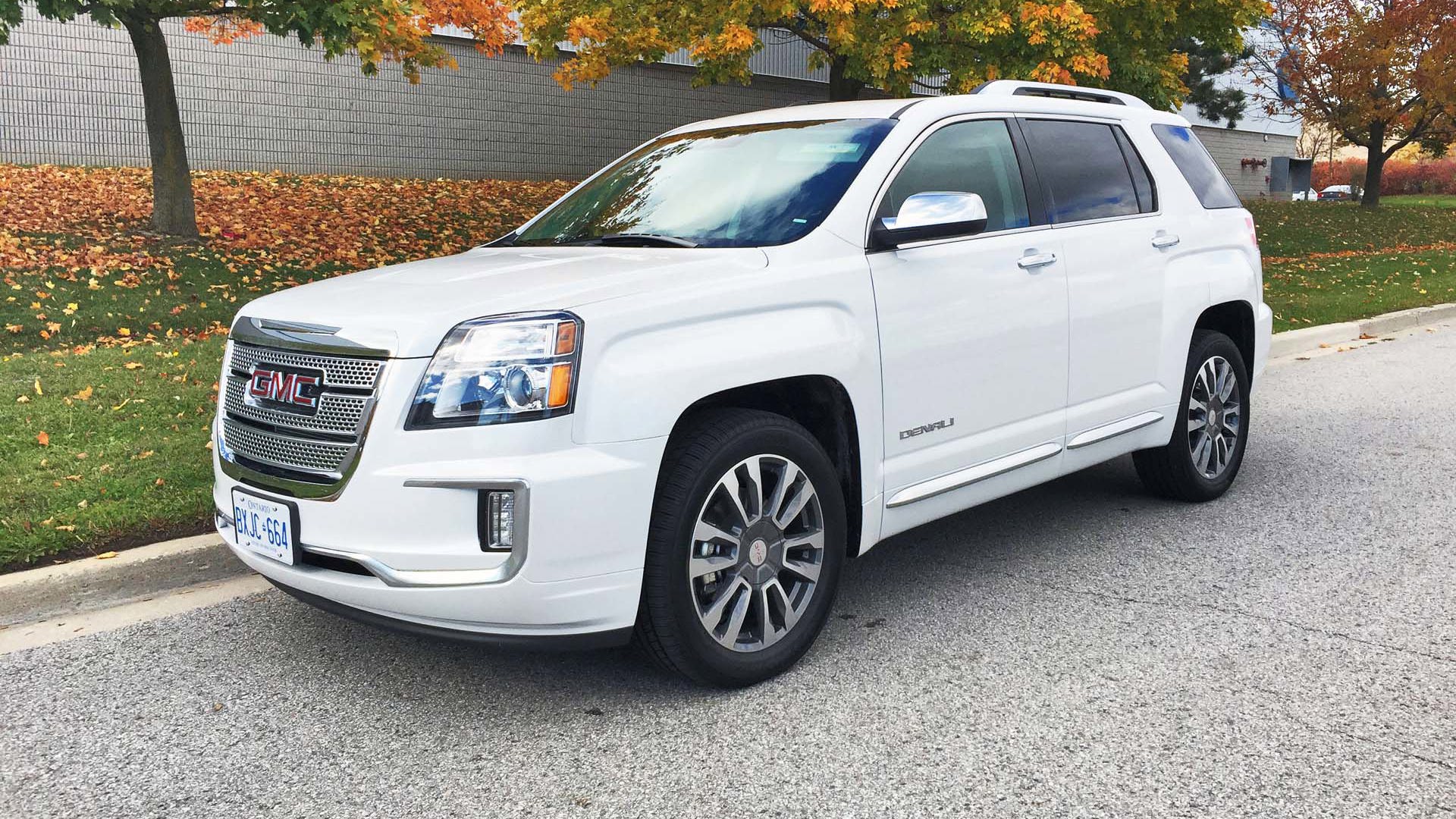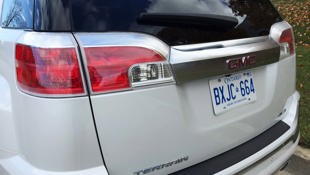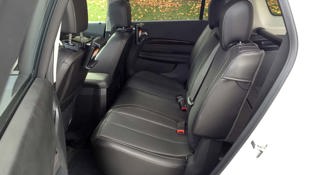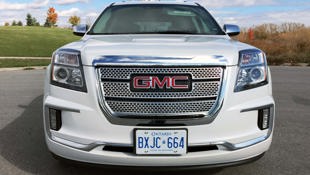 AutoTrader SCORE
AutoTrader SCORE
-
EXTERIOR STYLING4/10
-
INTERIOR7/10
-
PERFORMANCE8/10
-
COMFORT8/10
-
FUEL ECONOMY6/10
Since the GMC Terrain was introduced in 2010, its chunky styling has set it apart from most other compact SUVs including its General Motors stablemate, the Chevrolet Equinox. Personally, I don’t like the Terrain’s bulky lines, but according to General Motors, the Terrain’s styling is the top reason cited by buyers for purchasing it. And despite the Terrain’s macho appearance, 45 percent of the its buyers are female, according to GM.
Since the GMC Terrain was introduced in 2010, its chunky styling has set it apart from most other compact SUVs.
That might explain why after six years, styling revisions to the 2016 Terrain are minor. The Terrain’s super-sized fender flares and upright grille are still there, but look closely and you’ll see that the grille is now flush with the front bumper instead of separated from it, and the front bumper now incorporates C-shaped silver trim which wraps around the new LED daytime running lights on either side. As well, 2016 Terrains have more chrome in the grilles, especially the top Denali model with its ‘cheese-grater’ chrome grille. The Terrain’s hood now has a slightly raised ‘power dome’ and the tail lights have new silver trim. And all Terrains have new-style 17, 18 or 19-inch alloy wheels.
The 2016 Terrain’s interior is much the same as before, but base models have better quality seat material, the transmission shifter has more chrome, there’s a new storage shelf just above the large storage bin at the bottom of the centre stack, and some options that were previously available only in the Denali are now available in lower trim levels. Oh, and the CD player is gone.
Ranging in price from $28,215 to $42,365 (minus any GM rebates), the 2016 Terrain is priced slightly lower than its 2015 predecessor, though trim level designations are slightly different. A 2016 Terrain with front-wheel drive is available in two trim levels, SLE-1 ($28,215) and SLE-2 ($30,865) while the all-wheel drive Terrain is offered in four trim levels, SLE-1 ($30,415), SLE-2 ($33,065), SLT ($35,375), and Denali ($42,365). The 2016 Freight Charge is now $1,700, up from $1,550 in 2015.
As before, all GMC Terrains come with a standard 182-hp 2.4-litre DOHC 4-cylinder engine and six-speed automatic transmission. Optional in all trims except the base SLE-1 FWD and SLE-1 AWD is a 301-hp 3.6-litre DOHC V6 and six-speed automatic: it comes as part of an option package ($1,725) that includes a heavy-duty battery and alternator, different rear axle ratio, hydraulic power steering and dual exhausts. In the Denali, the subject of today’s test drive, the V6 option package ($2,165) also includes 19-inch tires and alloy wheels.
Crossover shoot-out: Comparison Test: Compact Crossover SUVs
Why buy the V6 instead of the four-cylinder? In a nutshell, the V6 engine provides better acceleration, smoother running, a quieter cabin, and increased towing capacity - but at the cost of increased fuel consumption.
NRCan fuel consumption ratings for the 2016 Terrain V6 FWD are 14.2 city/9.5 hwy/12.1 combined (L/100 km). With all-wheel drive, it’s rated at 14.9 city/10.1 city/12.8 combined. During my week with the Terrain Denali AWD V6 which involved a lot of freeway driving, my average fuel consumption display was showing 11.8 L/100 km. That compares to the Terrain FWD four-cylinder model which is rated 10.5/7.3/9.1 and the Terrain AWD four-cylinder rated at 11.5/8.2/10.0. Fortunately, both four-cylinder and V6 engines require Regular Unleaded gas.
Though classified as a compact SUV, the Terrain (and the Equinox) are larger and heavier than other compact SUVs but smaller than most mid-size SUVs. The Terrain weighs anywhere between 1,748 kg (3,853 lb) and 1,907 kg (4,204 lb) unloaded, so the extra power and torque of the V6 make a noticeable difference when brisk acceleration is required, when hauling a full load of passengers and cargo, or when towing a trailer. Independent acceleration tests by AJAC showed an unloaded Terrain Denali AWD V6 sprinting from 0 to 100 km/h in just 7.7 seconds, compared to 10.0 seconds for a Terrain FWD four-cylinder. Similarly, the V6 Terrain was faster from 80 to 120 km/h: 5.5 seconds vs 7.3 seconds, according to AJAC.
During my week with the Terrain Denali, I enjoyed the responsiveness of the V6 engine but was equally impressed with how smooth and quiet it is. There’s a muffled throaty roar when accelerating but most of the time it’s quiet and vibration-free. The V6-equipped Terrain is a great freeway cruiser, with plenty of power to overtake slower cars, and a quiet ride with minimal engine and wind noise. The driver sits up high with good visibility and despite its bulky shape, the Terrain resists side winds well. The engine turns over under 2,000 rpm at a steady 100 km/h on the flat and the 6-speed automatic transmission shifts so smoothly, it’s barely noticeable. A manual shifting mode allows manual shifting by pressing a plus or minus button on top of the shift handle. This can be useful for holding the transmission in a low gear when descending or ascending a steep hill especially with a trailer in tow.
One of the big advantages of the optional V6 engine is its extra towing capacity: with 272 lb-ft of torque, the 3.6L V6 provides a maximum towing capacity of 1,588 kg (3,500 lb); that compares to the four-cylinder powerplant’s towing capacity of 680 kg (1,500 lb). The Terrain’s optional Class II trailer package ($430) includes a 1 1/4-inch receiver hitch and 4-wire harness.
The Terrain’s optional electronic, on-demand all-wheel drive system is completely automatic and requires no driver intervention. It runs in front-wheel drive most of the time, but sends power to the rear wheels when conditions demand it. My only complaint was some scrubbing noises when making a full-lock U-turn. And speaking of U-turns, the Terrain has a very wide turning circle: with the standard 17-inch or 18-inch wheels, the turning diameter is 12.2 metres (40 ft.), but the Terrain Denali with the optional 19-inch wheels has a very poor turning diameter of 13 metres (42.6 ft.). On several occasions when making a tight turn, I had to back up and try again. Fortunately, the Terrain’s rearview camera and rear parking sensors made that easier. But really, that wide of a turning circle is unacceptable in a so-called ‘compact’ SUV.
Though tall and heavy, the Terrain handles well and feels very stable in the corners. That’s mostly because, though it looks like a truck, the Terrain is a crossover with car-like unit body construction, a long (2,857 mm) wheelbase, a wide track, and a four-wheel independent suspension. The Denali adds exclusive dual-flow shock absorbers which improve the ride by adapting to different road surfaces.
All Terrains come with standard StabiliTrak electronic stability control and traction control which help maintain traction and steering control in slippery situations. Braking chores are handled by standard four-wheel disc brakes with anti-lock, panic Brake Assist, and Hill Hold Assist to prevent rolling back on hills when starting off. Optional on some Terrains and standard on the Denali are Side Blind Zone Alert and Rear Cross-Traffic Alert which use radar to detect another vehicle in the Terrain’s blind spot or one crossing behind the Terrain. Another option package includes Lane Departure Warning and Forward Collision Alert which use a camera to warn the driver of an impending collision or unintended lane departure by sounding an alarm and flashing a warning light in the instrument cluster or side mirrors. These features don’t take the place of shoulder checks but they can prove a lifesaver when other vehicles “appear out of nowhere”.
As one of the largest vehicles in the compact SUV class, the Terrain has above-average interior room but not necessarily above-average cargo room. Its boxy shape provides plenty of headroom front and rear while its standard sliding rear seats can move forward and back up to 200 mm (8.0 in.) to provide generous rear legroom, or to improve cargo space behind the rear seats. The front seats in the Denali are very comfortable with multiple power adjustments including lumbar adjustment. The split rear seatbacks recline for greater comfort and one or both of the 60/40 split folding rear seatbacks can be folded down to accommodate various passenger and cargo arrangements.
The instrument panel’s sensible layout includes a four-gauge instrument cluster surrounding a configurable trip computer/information display, a 7-inch central touchscreen with a hood over top to reduce glare on the screen, and straightforward buttons for audio and climate controls. The steering wheel also features controls for telephone, audio volume and station seek, cruise control and an on/off switch for Lane Departure Warning and Forward Collision Alert. Voice activation commands can also operate the telephone, radio, and memory sticks plugged into the USB port in the centre storage bin.
GM’s IntelliLink system (available in SLE-2, SLT and Denali) includes navigation and 4G LTE connectivity and Wi-Fi hotspot that comes with a three-month, three-gigabyte data trial. It also includes OnStar with a free six-month subscription and Sirius/XM satellite radio with a free three-month subscription. IntelliLink enables Bluetooth audio, text messaging alerts, Siri iPhone capability, Android phone voice activation, and smartphone music apps, depending on whether your phone is compatible with the IntelliLink system.
Interior storage options are plentiful: a large open bin at the bottom of the centre stack has a 12-volt power outlet and a ledge above it is handy for phones. There’s a small open bin behind the shift lever and under the centre padded armrest is an iPad-sized bin with a lift-out tray and USB and auxiliary ports. Other spaces include door pockets, glovebox, and map pockets on the back of the front seats. There are four cupholders, two in front, two in the rear folding armrest.
The Terrain’s cargo volume of 894 litres behind the rear seats and 1,809 litres with the seatbacks folded down is adequate for most needs but is still less than some of its smaller competitors such as the Ford Escape (971/1,920 L) and Subaru Forester (892/1,940 L). That’s partly due to the Terrain’s large rear wheel housings which take up space on either side of the trunk. Still, unlike most SUVs, the cargo area behind the rear seats can be expanded by sliding the rear seats forward. The cargo area itself has a carpeted floor and plastic side walls with a couple of open storage bins on top and a 12-volt outlet. A sliding privacy cover is optional, even in the Denali. The rear liftgate can be programmed for different opening heights.
2016 GMC Terrain interiors come in “Jet Black” or “Light Titanium” colour schemes, and new for 2016 is a “Saddle Up” colour available exclusively in the SLT. The Denali’s premium interior includes leather seats with contrasting stitching and embossed Denali logos, leather-wrapped steering wheel with mahogany insert, mahogany trim on the doors and shift lever, illuminated sill plates, eight-way power driver and front passenger seats, and standard moonroof.
Worth a mention is GM’s warranty because it’s better than many others: 3 years/60,000 km full warranty, 5 years/160,000 km powertrain warranty, 5 years/160,000 km roadside assistance, and all scheduled lube, oil and regular maintenance for 2 years or 40,000 km.
If you love the GMC Terrain’s bulky looks and need a roomy, powerful and luxurious utility vehicle with all-weather capability and a good warranty, the Terrain AWD V6 may be the ticket. Just be prepared to spend more on gas and make wider U-turns.
The 2016 GMC Terrain is assembled in Ingersoll, Ontario.
| Warranty: 3 years/60,000 km; 5 years/160,000 km powertrain; 6 years/160,000 km corrosion perforation; 5 years/160,000 km roadside assistance Competitors: Chevrolet Equinox V6 Dodge Journey V6 Ford Escape 2.0T Hyundai Santa Fe 2.0T Jeep Cherokee V6 Mitsubishi Outlander V6 Nissan Murano Subaru Forester 2.0XT |
| Model Tested | 2016 GMC Terrain Denali V6 |
|---|---|
| Base Price | $42,365 |
| A/C Tax | $100 |
| Destination Fee | $1,700 |
| Price as Tested | $48,990 |
|
Optional Equipment
$4,825 (Preferred equipment group 5SA includes 3.6-litre V6, 19-inch bright alloy wheels, dual tip exhaust $2,165; White Frost tricoat paint $1,145; Trailer towing package with hitch receiver and 4-pin harness connector $430; cargo convenience package with rear privacy cover, net, cargo organizer $365; two universal tablet holders $290; interior protection package with all-weather floor mats and cargo mat $260; cargo close-out panel $170)
|
|




















































